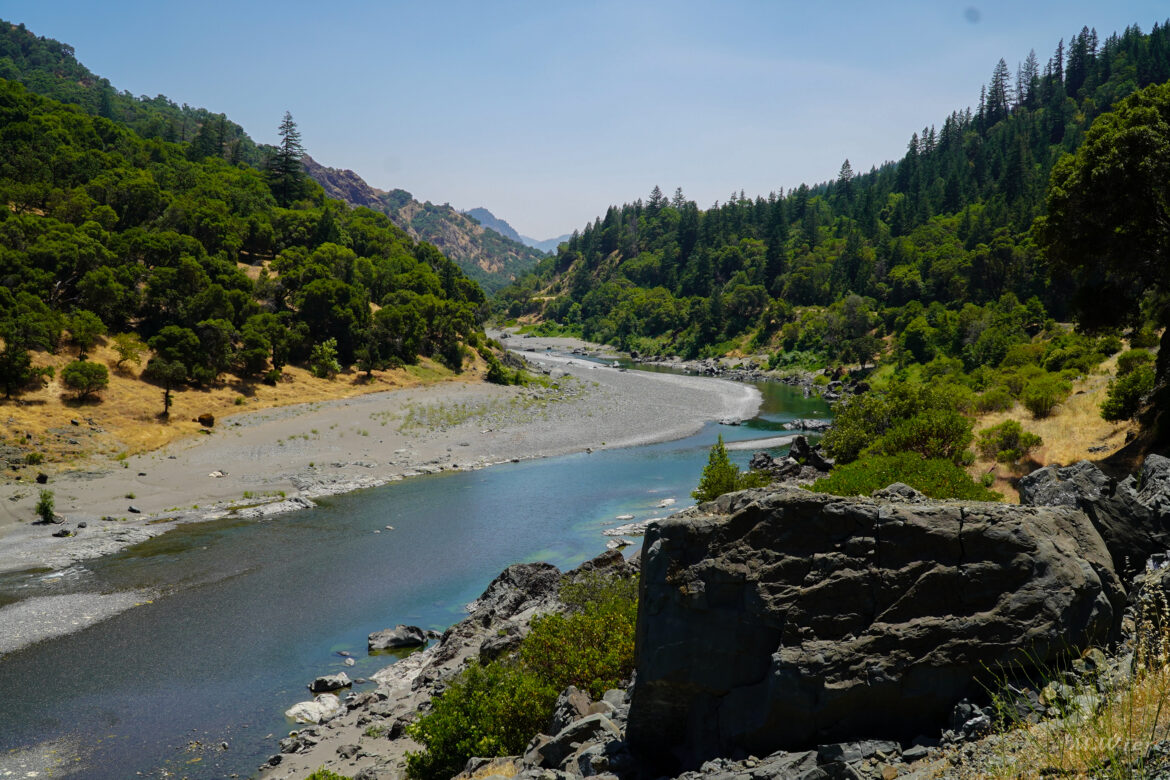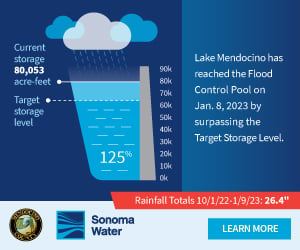MENDOCINO COUNTY, CA, 8/3/22 – As Pacific Gas & Electric (PG&E) moves toward decommissioning the Potter Valley Project, a coalition of environmental groups is readying materials to sue the power company over operations the groups say harm the Eel River’s salmon and trout populations and violate the federal Endangered Species Act (ESA).
The Potter Valley Project is a hydroelectric power plant — more than a century old — designed to generate power and divert water flows from the Eel River to the Russian River. The plant utilizes two dams: Cape Horn Dam at the Van Arsdale Reservoir and Scott Dam at Lake Pillsbury. The future of these dams remains murky and controversial, as government agencies, nonprofits, tribal nations, agricultural stakeholders, and other California citizens all have a vested interest in water rights and land stewardship in the two watersheds. For example, some Lake County residents oppose removing Scott Dam because of Lake Pillsbury’s community significance and value as a reservoir.
But those on all sides agree that the Eel River is a critical habitat for California’s populations of Chinook salmon and steelhead trout, making the fate of these species a significant factor that hangs in the balance when it comes to decommissioning the Potter Valley Project. Critics of the utility company argue that factors caused by the presence of the dams harm these threatened and endangered populations, but PG&E has not yet said whether decommissioning would involve removing the dams.
Friends of the Eel River, California Trout, Trout Unlimited, Pacific Coast Federation of Fishermen’s Associations, and the Institute for Fisheries Resources filed a notice of intent to sue PG&E under the Endangered Species Act on April 15, the day after PG&E’s 50-year license over the Potter Valley Project expired. The notice provided at least 60 days warning, giving PG&E a chance to respond to its allegations; the environmental groups hoped that the utility would take steps to eliminate the outlined conditions of “take,” or harm caused to fish, prior to actual litigation.
Although their representatives cannot speak to the specifics of recent dialogue with PG&E, it seems that hope has not manifested.
“We’ve essentially been rebuffed by PG&E, who across the board has been negligent in their caretaking of the resources they were put in charge of,” California Trout’s Legal & Policy Director Redgie Collins told The Mendocino Voice. “We think the best solution is to then move quickly and efficiently towards the disposition of this project.”
The impetus for their lawsuit, which has not yet been filed, stemmed in part from red flags raised by the National Marine Fisheries Service (NMFS), the government authority on marine life, in mid-March. NMFS wrote to the Federal Energy Regulatory Commission (FERC) expressing concerns that project operations were negatively impacting salmon and steelhead survival and requesting to consult on the project again under the ESA. NFMS said its Biological Opinion and incidental “take” statement on Potter Valley operations, authorizing some conditions for take back in 2002, did not cover the activities of Cape Horn Dam and its associated infrastructure; fishway maintenance; and flow operations to achieve fish passage at the passage facility. NMFS also said that FERC’s subsequent approval of Potter Valley Project modifications and operations did not undergo ESA consultation or consultation with regards to Pacific Coast Salmon Essential Fish Habitat protections.
NMFS alleges that this resulted in unauthorized impacts on fish — and also said its 20-year opinion authorizing the Project’s conditions for take elapsed April 14, writing, “The 20-year duration of the proposed action is a central component of the Opinion.” As such, in 2022, the agency requested that eight different interim protective measures be incorporated into the project to protect fish during this period of flux prior to decommissioning, including implementing a water temperature management plan, an adult escapement monitoring plan, and a stream gauging plan. More details on NMFS’ request are available in their letter.
But PG&E disputes the notion that Potter Valley operations have illegal detrimental impacts on endangered fish populations.
“PG&E is not aware of any evidence in the voluminous record associated with the Project indicating that Project operations under the license are causing an unauthorized take of listed salmonids,” Paul Moreno, Marketing & Communications principal for PG&E, told The Mendocino Voice in a written statement. “There are a multitude of adverse influences along the approximately 160-mile-long Eel River corridor that affect salmonids and PG&E believes its operations benefit salmonids by storing and providing water that otherwise would not be available for release, particularly during dry seasons.”
The suing environmental groups counter that the project limits salmon and steelhead access to critical pieces of their habitat, closes fishways at key moments in their life cycle due to reduced water flows, encourages otter predation by virtue of fishway design, and facilitates inhospitable temperatures. Collins said they think NMFS’ protective measures would be a good place to start in rectifying the alleged harm to fish.
“I think [removing the Scott dam] would make a big difference for the fate of Eel River salmon and steelhead — there’s certainly a lot of other issues in the river that we need to deal with — but taking the dam out is by far the single biggest thing we could do to help fisheries on the Eel.” Charlie Schneider, Trout Unlimited’s California North Coast coordinator, said in an interview with The Voice.
Further, their lawsuit would seek to prove that the expiration of the license and NMFS’ biological opinion mean conditions for take that were allowed under those agreements are no longer legal. But PG&E disagrees entirely, writing in a response letter to NMFS on July 11 that “the NMFS 2002 BiOp and [incidental take statement] do not have a 20-year term or any other expiration date.”
“It seems that they plan on doing exactly nothing more unless forced to, which is pretty disappointing, but not unexpected given PG&E’s track record,” Schneider said. As such, the groups are moving forward in preparing litigation. Collins said he believes the utility’s July 11 response was meant not just to respond to NMFS’ letter, but to refute a possible lawsuit.
“Their legal resources are immense and I thought the brief they wrote back to NMFS, directed towards us, was well-written and persuasive,” he said, adding, “The biological opinion is no longer valid. That’s a fundamental disagreement, and if we have to talk about it in a court of law we’re happy to do so.”
Also on July 11, PG&E submitted an initial timeline for its decommissioning process — which includes developing a clear plan in the next year. The utility plans to file its application for surrender and its decommission plan within 30 months after FERC’s approval of this timeline.
“PG&E has not made any determination with respect to its decommissioning proposal, including whether facilities will be removed or remain in place,” Moreno said. “There are many stakeholders with an interest in the disposition of the Potter Valley Project facilities, and PG&E’s schedule provides for opportunity for input from these stakeholders to inform PG&E’s ultimate decommissioning proposal.”
Collins was one of many partners to work on the Two-Basin Solution proposed by Congressman Jared Huffman’s Ad Hoc Committee in 2017, when PG&E began to explore relicensing the project. The committee’s primary goal was to facilitate improved fish passage and reliable water supply in partnership, in part through plans for the removal of Scott Dam and modification of Cape Horn Dam.
While PG&E eventually rejected the Ad Hoc Committee’s proposal over funding issues and a misaligned timeline to form a regional entity as the licensee, Collins said California Trout and other organizations still have the results of millions of dollars worth of feasibility studies. He hopes that PG&E will look to plans from the Two-Basin Solution in its decommissioning process — and also believes this prior work could shorten the utility’s proposed 30-month timeline.
“This project has the potential to be a historic dam removal project,” he said, adding, “Any way we can push PG&E on that 30-month timeline will be better, because every day we do not do that, fish on the Eel River suffer. PG&E basically let this entire region dwell on this and cooked up individual rivalries on purpose in order to get them a little bit less heat directly, but ultimately PG&E has the keys here, and if they want to move this process quicker, they can.”
The Mendocino Voice will provide updates on our website as the decommissioning process advances.
Note: Kate Fishman covers the environment & natural resources for The Mendocino Voice in partnership with a Report For America. Her position is funded by the Community Foundation of Mendocino, Report for America, & our readers. You can support Fishman’s work with a tax-deductible donation here or by emailing [email protected]. Contact her at KFishman@mendovoice.com or at (707) 234-7735. The Voice maintains editorial control and independence.





Coho salmon are not found on the southernmost section of the Eel River affected by the dams – Coho like cooler habitat such as found on the South Fork nearer the coast, which joins the mainstem Eel River far downstream. Since they are not plentiful there, and since that fork is not affected by the presence of the dam, it’s worth asking why not, and what measures might be taken to help fish there.
We know that salmonids are adversely affected by water runoff that contains tire residue from roads, and also that there are many culverts in the river system that prevent fish from accessing various creeks. These projects would be much less expensive and likely would produce far more benefit with fewer adverse consequences for both people and fish than the dam removal.
With climate change, we are seeing far more boom-and-bust rain events in this region. Water storage is going to be necessary for both humans and fish if we want to ensure year-round water in the upper Eel River system. The inflow data we have shows that in dry years, the natural flows in the area between Lake Pillsbury and Van Arsdale will not be sufficient to have surface water by the end of summer – that it is only the presence of stored winter water released from the dam in summer that is keeping the water flowing.
Stored in Lake Pillsbury is released at the base of Scott Dam to HELP salmon and steelhead. This will not be possible if the dam is removed. The fishery groups claim Eel River dams are causing the extinction of salmonids, yet these same groups support the FERC-authorized temporary flow variance to assure there will be sufficient water supply for cold water block releases to aid the salmon and steelhead later this year. This will not be possible without Scott Dam and Lake Pillsbury.
The Eel River watershed is 3,684 square miles and 3,396 square miles or 92% of it is below Scott Dam. The remaining 288 square miles (about 8%) above the dam is known to be the hottest, driest portion of the watershed. Surely there are other effective fish mitigation enhancements that could be implemented from Scott Dam to the Pacific Ocean in lieu of dam removal. People and fish need this year-round water source.
Let’s hope local, state and federal entities and politicians soon realize that dam removal is not in the best interests of the people or the fish (or the rest of the wildlife for that matter.)
And by the way, this is not necessarily a done deal. Anything can happen during the surrender process, i.e., infrastructure may or may not be removed, a new license may or may not be issued, the PVP may become a water storage project rather than a hydropower project, in which case FERC would no longer be involved.
You are deeply and ridiculously mistaken. The 12 miles of hot, predator laden river between the dams, is not even close to the 200+ miles of headwater streams above the dams. Local, state and federal entities and politicians have to take into account the actual facts of what is happening in the Eel River. Just because Russian River vineyards have been minimizing the impacts the dams have on salmon doesn’t mean those arguments are true.
No one can afford the dams, PG&E doesn’t want them and they are enormous liabilities for any future owner. The writing is on the wall, the dams are coming out.
Many things can be done for the Salmonids in the Eel and Russian Rivers. They all need water to be successful. Dam removal is asinine. How can the fisheries claim they need cold water from Lake Pillsbury for the salmonoids survival and want to remove Scott Dam. They are talking out of both sides of their mouth.
People need water, fish need water. We can have both with common sense and proper water management. Keep the dams for water supply and help the fish through tributary improvements and the following.
1) Create a hatch box program that was successful on the Mattole Rver for King Salmon and now being done on the McCloud branch flowing into Lake Shasta.
2) Reduce preditor problems like removing otters from fish passsge areas. Eradicate the Pike minnow population.
3) Monitor illegal water diversions along the whole Eel River and Russian River Systems.
4) Provide modern fish ladders like the successful one on the Nimbus Dam or the use of the Whoosh System.
We have the ability to make things work for both our human needs and for the fish. Just need the political will power!
Its pretty simple actually. Even the limited cold water released below dam still doesn’t make up for the habitat blocked by the dams. There is more fish supporting cold water above the dams than below them and multiple studies say that.
Want to recover fish? Remove the dams.
Want to pretend to recover fish so you can have your vineyard or lake house? Fish ladders, hatch boxes and woosh.
People and fish both need water, the problem here is the Russian River has been taking more than their fair share.